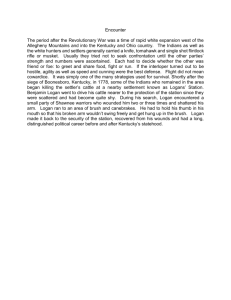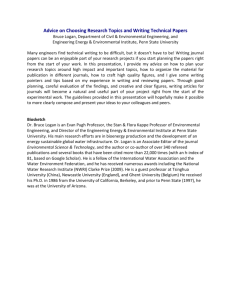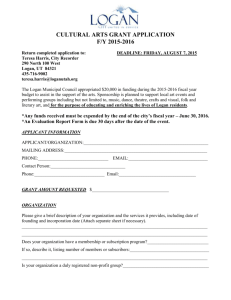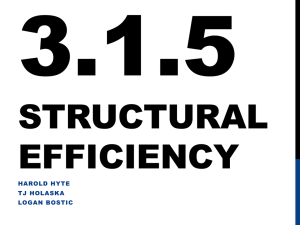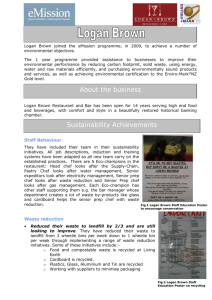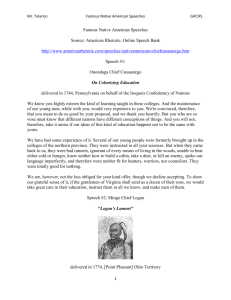technical and user guide
advertisement
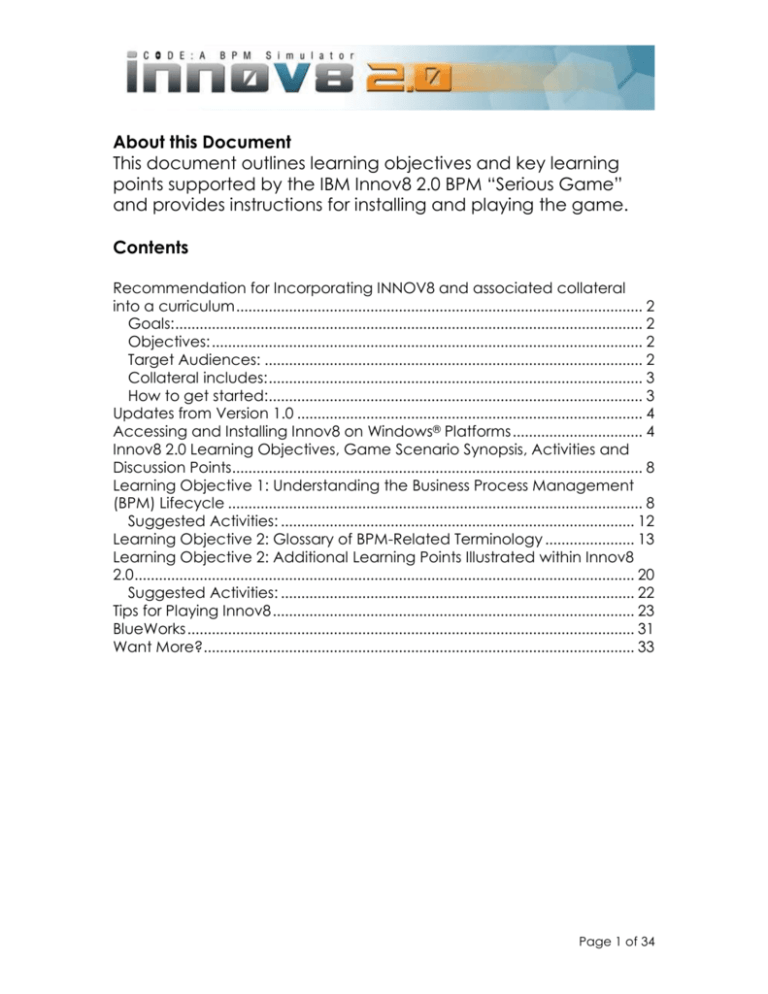
About this Document This document outlines learning objectives and key learning points supported by the IBM Innov8 2.0 BPM “Serious Game” and provides instructions for installing and playing the game. Contents Recommendation for Incorporating INNOV8 and associated collateral into a curriculum .................................................................................................... 2 Goals:................................................................................................................... 2 Objectives: .......................................................................................................... 2 Target Audiences: ............................................................................................. 2 Collateral includes: ............................................................................................ 3 How to get started:............................................................................................ 3 Updates from Version 1.0 ..................................................................................... 4 Accessing and Installing Innov8 on Windows® Platforms ................................ 4 Innov8 2.0 Learning Objectives, Game Scenario Synopsis, Activities and Discussion Points..................................................................................................... 8 Learning Objective 1: Understanding the Business Process Management (BPM) Lifecycle ...................................................................................................... 8 Suggested Activities: ....................................................................................... 12 Learning Objective 2: Glossary of BPM-Related Terminology ...................... 13 Learning Objective 2: Additional Learning Points Illustrated within Innov8 2.0........................................................................................................................... 20 Suggested Activities: ....................................................................................... 22 Tips for Playing Innov8 ......................................................................................... 23 BlueWorks .............................................................................................................. 31 Want More?.......................................................................................................... 33 Page 1 of 34 Recommendation for Incorporating INNOV8 and associated collateral into a curriculum Goals: The goals of INNOV8 are - To introduce the basic concepts of Services Oriented Architecture (SOA) and Business Process Management (BPM) to future business and IT leaders - To address a skills gap in SOA and BPM - To provide a complimentary education offering that can be incorporated into IBM’s existing BPM curriculum Objectives: Upon successfully completing the game and subsequent classroom activities and discussion points, the student should be able to: 1. Understand the basic business process management lifecycle, from process discovery and modeling through process monitoring and management. 2. Understand additional key business process management terminology and concepts Target Audiences: 1. Business school professors and students (undergraduate, MBA and Executive MBA programs) 2. Computer science professors and students Page 2 of 34 3. Customers: Current business / IT analysts 4. Customers: Call center agents 5. Customers: Operations specialists Collateral includes: 1. INNOV8 2.0 Academic Edition downloadable game 2. Two mini games: supply chain & traffic (online) 3. Smart Work: 3D Interactive case studies (online) 4. Pre and post usage surveys (online) 5. developerWorks Communities (online) 6. Instruction Manual 7. BlueWorks Models How to get started: Step 1: We recommend that the course begin with the Innov8 2.0 Academic edition of the game in a facilitated environment, using this manual as a guide. Review this entire guide for suggested activities and discussion points based on key insights spread throughout the game. Please have your students complete the surveys linked to from the final score page. The data from these surveys will help prove our case for the creation of more games of this nature. Step 2: Upon completion, the game will show a final screen with links to the online mini games. These mini games are a great way to extend the BPM learning into new scenarios. Step 3: Ask your participants to experience Smart Work: 3D Interactive to see how real customers tackled the problems showcased in the online mini games. Page 3 of 34 http://www01.ibm.com/software/solutions/soa/innov8/smartwork.htm l Step 4: Finally, our developerWorks communities are a great way to share experiences post-gameplay. These communities will include thought leaders who are practicing within the areas of traffic, supply chain and customer service and who will be mingling with students and professionals alike. Updates from Version 1.0 Puzzle interface redesign for all levels Glossary Addition 3D Interface upgrade Toolset upgrade Surveys (online) Community (online) Additional Mini games (online) New events in Nerve center Accessing and Installing Innov8 on Windows® Platforms 1. Customers: Innov8 is available at no charge to IBM customers through our Customer Ambassador Program but is not available for public distribution or resale. IBM ambassadors must register their customers in order for their customers to be able to use Innov8. Customers must agree to the license terms before playing. 2. Academics: Innov8 is available at no charge to academic faculty for teaching or research purposes. It is currently being distributed through the IBM Academic Initiative. If you are not already a member of the IBM Academic Initiative, you Page 4 of 34 will be required to join to gain access to INNOV8. Membership is free. Beyond providing access to Innov8, the AI program provides faculty members with many benefits, including free use of an extensive portfolio of IBM software products and education assets. You can join the IBM Academic Initiative at http://www304.ibm.com/jct09002c/university/scholars/academicinitiative/ 3. Note the following Innov8 Technical Requirements OS: Microsoft Windows Vista/XP/2000/Me/98 RAM: 128 MB RAM Disk space: Approximately 750MB Processor: Pentium III or Athlon 800 MHz or greater Sound: 16-bit DirectX 9.0c-compatible sound card and drivers CD-ROM: 4x CD-ROM drive and drivers Video card: 3D hardware accelerator card, for optimal performance: - nVidia GeForce2 or equivalent ATI card (or higher); - DirectX 9.0c (compliant 32 MB Video card and drivers) 4. Steps have been taken to enable Innov8 to run on systems that do not meet the precise video card (nVidia and ATI) specifications stated above. Generally speaking, if your system is DirectX 9.03c compliant, there is a reasonable expectation that the game will run. Inevitably, there will be exceptions to this rule-of-thumb. Moreover, in some environments – where key graphics card functions have been emulated within the software – Innov8 may run but with unacceptably slow performance. 5. The current set-up should allow the game to launch regardless of the video feature set available on your system. If a warning message appears, there is a chance the game Page 5 of 34 will exit shortly after that message. Otherwise the game should function correctly. 6. If your system is DirectX 9.03c compliant and you still experience problems installing or launching the game, please use the following procedure to collect information for our developers. a) Click “Start” on the Windows taskbar at the bottom of the screen. b) Click “Run” c) Type in “dxdiag”; without the quotes d) Click “Ok”. e) Click the third tab labeled “Display” to view your video card and driver information f) Click “Save all information” to save the screen information to a new file on your computer. g) Send the saved file to Michael Buss (mbuss@us.ibm.com) 7. If you are replacing a previously-installed version of Innov8, go to Start > Settings > Control Panel and use Add or Remove Programs to remove the previous installation of Innov8 from your system before installing the new version. 8. Once a member of IBM Academic Initiative (see #1), you can download Innov8 by following the instructions at: http://www.ibm.com/innov8 9. Note: We request that you do not provide this link directly to students, but instead distribute the zip file and instructions using your own means. 10. Navigate to the down-loaded zip file. Right-click on it and click Extract All… and use the Compressed Folders Extraction Wizard to extract the contents of the zip file. Page 6 of 34 11. Find the extracted setup.exe file and double-click to invoke the Innov8 InstallShield Wizard. 12. Click Next on the InstallShield welcome screen. 13. Accept the terms of the IBM license agreement and click Next. 14. Click Next to install to the selected folder, or click Change to install to a different folder. 15. Click Install to begin the installation. 16. Click Yes to accept the Microsoft DirectX Software License Terms. 17. Click Finish to exit the InstallShield Wizard. 18. The install process should create a shortcut on your Windows Desktop. Click the shortcut or navigate to where Innov8 has been installed, find INNOV8.exe, and double-click to launch the game. 19. If a shortcut is not automatically created on your desktop, to expedite launching in the future, right-click on INNOV8.exe and click Create Shortcut, then drag the Shortcut to INNOV8.exe file to your desktop. As long as you install future copies of Innov8 in the same location, the same shortcut should work. Page 7 of 34 It is possible to run Innov8 in full screen mode. We do not recommend full screen mode at this time, as performance is slower and can result in situations where you ‘lose’ your cursor. However, if you want to test it or just see how it looks, you can go to Start > Run, click Browse to locate the INNOV8.exe file, and then add the switch “/fullscreen” (without the quotes) after the path/file name. Then click OK to launch the game.Innov8 2.0 Learning Objectives, Game Scenario Synopsis, Activities and Discussion Points This section provides the learning objectives, game scenario synopsis, and suggested activities and discussion points for use in both an academic and training environment. Upon successfully completing the game and subsequent classroom activities and discussion points, the student should be able to: 1. Understand the basic business process management lifecycle, from process discovery and modeling through process monitoring and management. 2. Understand additional key business process management terminology and concepts Learning Objective 1: Understanding the Business Process Management (BPM) Lifecycle The Innov8 storyline and game flow are meant to portray the progression of the game’s main character through and around key activities over the life of a virtual process improvement project… and hence through the stages of the BPM Lifecycle: Page 8 of 34 BPM Lifecycle Activity Game Level 1 Game Level 2 Game Level 3 Understanding the As-Is Business Process Building the To-Be Business Process Monitoring and Managing the New Business Process BPM Lifecycle Over- “BPM 101” video shown on the large screen in the Level view 1 entry area illustrates and explains the BPM lifecycle at a high level Prioritizing Process Improvement Projects Process Discovery Opening Cinematic: Mike provides Logan with a Component Business Model Heat Map to guide the process improvement effort Logan obtains an existing process map from the computer on Stavros’ desk. Stella helps Logan understand how the As-Is process has changed. Logan discovers data to populate the process model: - KPI’s from Operations - Headcount levels from HR - Labor costs from Finance - Call statistics from Operations As data is collected, Logan incorporates it into the As-Is model. (Player can view by clicking Net > Model) Process Model Construction Logan initially imports a process map Stella helps Logan create a new model by dragging and dropping elements into process model swim lanes. Logan selects design elements that match stated requirements. Page 9 of 34 BPM Lifecycle Activity Game Level 1 Game Level 2 Game Level 3 Understanding the As-Is Business Process Building the To-Be Business Process Monitoring and Managing the New Business Process Logan participates in global collaboration to collect To-Be process requirements from colleagues. Process RequirementsGathering Sharon shares input on process issues goldcustomer input on current process issues Process Analysis Logan finds a proposal on Virtual Agent (VA) technology which contains analysis of potential VA effectiveness. Logan uses simulation to analyze the performance of the As-Is model and validate it against empirical data. Process Design Colleagues provide Logan with information that they have derived through their own analysis: Logan uses simulation to analyze use cases and answer “what-if” questions from Mike. Logan can review and analyze process metrics within the KPI VIEW, to determine necessary process adjustments. Logan publishes simulation results to colleagues to garner validation and feedback. Logan selects design elements that match stated requirements. Logan publishes step-bystep model refinements to garner feedback. Page 10 of 34 BPM Lifecycle Activity Game Level 1 Game Level 2 Game Level 3 Understanding the As-Is Business Process Building the To-Be Business Process Monitoring and Managing the New Business Process Sam and Tomas mention various implementation tasks during global collaboration. Staged implementation of improvements occurs as Business Rules, Knowledge Base, Virtual Agent technology, and customer interfaces are introduced separately over time. Process Implementa- The As-Is process has altion and Deployment ready been deployed when Logan is first introduced to the situation. Sam refers to implementation and deployment in first interaction with Logan. In IT, Logan (optionally) discovers software product boxes for tools used by IT to implement and deploy processes. Logan (optionally) discovers Business Process Execution Language (BPEL) diagram on whiteboard within IT Process Monitoring Logan finds KPI’s during (optional) interaction with Sharon and posted on wall within Operations. Logan can monitor process effectiveness through the HOLISTIC VIEW within the Nerve Center User Interface (UI). Logan can review “realtime” Key Performance Indicators within the KPI VIEW. Logan receives “real-time” process alerts. Page 11 of 34 BPM Lifecycle Activity Game Level 1 Game Level 2 Game Level 3 Understanding the As-Is Business Process Building the To-Be Business Process Monitoring and Managing the New Business Process Process Management Sam mentions dynamic business rules capability during collaboration on routing schemes. Logan adjusts business rules to modify process flow dynamically. Logan adjusts human resource levels. Logan makes investment decisions regarding Virtual Agent technology. Logan can switch in-flight workload between partners. Continuous Improvement and Optimization Mike reconvenes the global collaboration team to consider feedback from gold customers and make further process improvements Mike sees the need for continued process refinement after the initial To-Be model is put into production. Suggested Activities: 1. Discuss the reasoning behind decisions made in the game. 2. Discuss possible resource allocations as a group, and try running through game again with levels decided by consensus. Page 12 of 34 Learning Objective 2: Glossary of BPM-Related Terminology Innov8 introduces the student to a number of terms and phrases associated with Business Process Management: Word or Phrase Activity Alert Architect Definition Context within Innov8 Mentioned by Sam during the Drag & A unit of work performed in a business Drop tutorial and by Stella as she describes how the process really works. process. Sub-processes, tasks, and services are examples of activities. In the context of BPM, an automatic notification from the process server that a significant event has happened or a key threshold has been reached. The panel in the upper right of the Level 3 Nerve Center monitor screen shows “real-time” process alerts. In the context of IT, 1) (verb) to map available hardware, software, message protocols, etc, against application or process requirements, in an effort to meet key metrics around performance, security, budget, etc. 2) (noun) a specialized role within the software development community that concerns itself with the above. Architecting processes is mentioned in the BPM video that plays on the screen in the Level 1 entry area. “As-Is” Process Model A model of a business process as it exists currently, prior to process improvement efforts. In the Level 2 Collaboration exercise, Logan meets Tomas, Lead IT Architect Mentioned by Sam when Logan first meets her, and again by Mike at the beginning of the Level 2 Collaboration meeting. Business Agility The ability of a business to respond At beginning of the Level 2 Collaborarapidly to marketplace dynamics, tion meeting, Mike indicates he is seekwithout delay due to required IT infra- ing greater Business Agility. structure changes Business Analyst A specialist who analyzes business At the beginning of game play, Stavros needs and problems, consults with introduces himself as “Business Analyst users and stakeholders to identify op- Extraordinaire”. portunities for improving business return through information technology, and transforms requirements into a technical form. Page 13 of 34 Word or Phrase Definition Business Architecture “The grouping of business functions and related business objects into clusters (“business domains”) over which meaningful accountability can be taken” (Wikipedia) Business Process Any activity or set of activities performed within a company or organization. In the context of modeling software, a process is a progressively continuing procedure consisting of a series of activities that are systematically directed toward a particular result or end. Context within Innov8 Mike provides Logan with a “Business Architecture Heat Map” during the opening cinematic. Once game play begins, the player can view AFTER Inc.’s Business Architecture by clicking Net>Heat Map Mike introduces the term in the Opening Cinematic as he gives Logan her mission. A definition and illustration are provided within the BPM movie shown on the screen in the entry area of Level 1. A BPEL diagram appears on a whiteBusiness Process Exe- A business process modeling language used by IT for the formal speci- board on the rear left wall in the main IT cution Language fication of business processes and room. (BPEL) business interaction protocols. BPEL is an executable language that orchestrates actions; for example, when to send or wait for messages. BPEL extends the basic Web services interaction model to support Business-toBusiness exchanges. Business Process Man- A structured, often cross-functional approach - combining management agement (BPM) methods with information technology - to improving business processes over time or adapting them to meet new customer or market needs. Mike introduces the term in the Opening Cinematic as he gives Logan her mission. A definition and illustration are provided within the BPM movie shown on the screen in the entry area of Level 1. Referred to and illustrated within the Business Process Man- The lifecycle of managementinitiated activities that lead to contin- BPM movie shown on the screen in the agement Lifecycle uous process improvement over time. entry area of Level 1. You architect and build a base process, implement the process, observe and analyze process performance, and then make changes to improve the process. And then you repeat the cycle, over and over, until the process is eventually retired. Business Process Mod- An abstract or conceptual represen- First mentioned by Sam when meeting tation of a business process usually Logan. el developed for understanding, analyzing, improving, or replacing the process being represented. A model can Page 14 of 34 Word or Phrase Definition Context within Innov8 include representations of activities, relationships, information flows, and constraints. Business Rules In the context of BPM, a programming device by which business strategies are implemented and automatically enforced by the application or Process Server. Modern BPM systems often allow the Line of Business to modify business rules “on the fly” without having to modify the underlying IT infrastructure. CIO (Chief Information A commonly used job title for the highest-ranking executive who overOfficer) sees the information technology group within an enterprise. Collaboration Connection Business Rules are mentioned first by Sam during the Level 2 Collaboration, as a means to route calls to Partners under certain conditions. When Logan first meets Sam, Sam indicates that the CIO has mandated the use of the modeling software Logan will use. “A structured, recursive process where two or more people work together by building consensus and sharing knowledge in an intellectual endeavor toward a common goal which is typically creative in nature. Collaboration does not require leadership and can even bring better results through decentralization and egalitarianism.” (Wikipedia) Collaboration is first mentioned by Sharon if/when Logan meets her in the Level 1 entry area. A link between two elements in a process map or diagram. Connections are typically used to specify the chronological sequence of activities in a process. Mentioned by Sam in the Drag and Drop tutorial. Then, as Logan builds the As-Is model, we see the model elements auto-connect. She and Mike co-host the “Global Collaboration” meeting that is the basis for Level 2. Connections also appear in various model diagrams in the BPM video and throughout Levels 1, 2, and 3. During the Collaboration, Mike asks his Core Activities (a.k.a. Strategic business capabilities that must be performed well, in order for team to identify non-core activities that core competencies) the business to thrive. Businesses often can be minimized. seek synergy with one another, by outsourcing their own non-core activities to external partners who view the very same activities as their core activities. Dashboard In the context of IT, a business management tool used to visually ascertain the status (or "health") of a business process or enterprise via key performance indicators. The monitor screen that Logan sees in the Level 3 Nerve Center (with its KPI panel) is representative of a business dashboard. Page 15 of 34 Word or Phrase Decision Symbol Definition A process element that routes an input to one of several alternative outgoing paths, depending on its condition. A decision is like a question that determines the exact set of activities to perform during a process run. Questions might include "What type of order?" and "How will the order be shipped?" Context within Innov8 The “decision” symbol is defined and first used during the Drag and Drop challenge in Level1. It also appears in model diagrams in the BPM video and throughout Levels 2 and 3. Flexible Infrastructure An IT infrastructure that has been ar- Mike suggests in the Level 2 Collaborachitected specifically to provide busi- tion that proposed changes are resultness agility - capable of responding ing in a more Flexible Infrastructure. dynamically to both planned and unplanned business events. “Heat Map” “Import” In the context of Component Business Modeling, a graphical representation of data wherein the concentration of multiple factors under investigation is illustrated by a corresponding concentration of colors in the model. A heat map can be used to identify the greatest opportunities for reducing costs, delivering competitive advantage, or other factors. Mike provides Logan with a “Business Architecture Heat Map” during the opening cinematic. To bring a model design – created within one tool – into a second tool, thereby saving time and reducing human errors due to re-keying. For example, a model developed by a Business Analyst may be imported into development or integration tooling used by IT. Near the end of the Level 2 Collaboration, Sam indicates she will import Logan’s To-Be model into tooling used by IT. Key Performance Indi- A significant measurement used to track performance against a business cators (KPI’s) objective. A key performance indicator has a target or ranges, or both, to measure the improvement or deterioration in the performance of an activity that is critical to the business. Once game play begins, the player can view AFTER Inc.’s Business Architecture by clicking Laptop>Files>Heat Map First mentioned by Sharon if/when Logan meets her in the Level 1 entry area. Later, Logan finds AFTER Inc Call Center KPI’s posted on a wall in Operations. Knowledge Base (a.k.a. Repository) “A special kind of database for knowledge management. It provides the means for the computerized collection, organization, and retrieval of knowledge.” (Wikipedia) Mentioned by Sam during the Level 2 Collaboration as a means to collect and store call information for later retrieval. Merge Symbol A process element that recombines multiple processing paths, typically after a decision. A merge brings sev- A “merge” symbol is defined and first used during the Drag and Drop challenge in Level1. Page 16 of 34 Word or Phrase Definition Context within Innov8 eral alternative paths together. Portal “A Web framework for integrating in- The monitor screen that Logan sees in formation, applications, and process- the Level 3 Nerve Center is representaes across organizational boundaries.” tive of a business portal. (Wikipedia) Process Automation A process that businesses use to con- In Level 1 play, Logan may discover a tain costs, by deploying and integrat- proposal for Virtual Agent technology ing software applicationss and cutthat automates call-handling. ting labor wherever possible. During the Level 2 Collaboration, Mike asks if it is not possible to automate the handling of certain calls. Process Deployment The actions that IT takes, to move a process from the development and test environment into production. Deployment is mentioned in the BPM video that plays on the screen in the Level 1 entry area. In the main IT room, Logan may examine product boxes for software that AFTER Inc apparently uses to “deploy and run business processes. During the Level 2 Collaboration, Sam Process Implementa- The actions that IT takes, to convert the business process model into work- mentions implementing Virtual Agent tion ing application code that runs on and Knowledge Base technologies. specific computer hardware and software. Process Improvement 1. A proactive set of management activities aimed at identifying, analyzing, adapting and improving existing business processes to meet specific goals and objectives. 2. An incremental result of such activity. During the BPM video shown on the screen in the Level 1 entry area, process improvement is mentioned as a basic objective of BPM. Process Innovation A change in a process which results in a radical shift in process metrics and/or structure, typically in response to evolutionary changes in the marketplace. During the BPM video shown on the screen in the Level 1 entry area, innovation is mentioned as a means to dramatically reduce the cost and time of business adaptation. Process Map (a.k.a. Process Diagram) A diagram that depicts the activities and decisions that are performed within a business process and the order (chronological time sequence) in which they are performed. Process maps are augmented with various element attributes, such as costs and durations, to yield more comprehensive process models to support simulations and other process analysis tasks. When Sam first meets Logan Sam advises to look for someone in Operations who may have a Process Map to use as a starting point. Logan retrieves one of several process maps from the computer on Stavros’ desk. Page 17 of 34 Word or Phrase Process Model Process Model Elements Definition A typically visual representation of a real business process that is composed of the individual steps or activities that make up the process, contains the conditions that dictate when they occur, and identifies the resources required for its performance or run. Context within Innov8 First mentioned in the BPM video that plays on the screen in the Level 1 entry way, and again by Sam when Logan first meets her. Distinct, self-contained units of a busi- Sam discusses the various model eleness process map or model. Examples ments during the tutorial for the Drag of elements are tasks, decisions, and Drop exercise. merges, and connections. Process Server Specialized software platform for executing and “choreographing” business processes during run-time (i.e. in production). During the Level 2 Collaboration, Tomas mentions the Process Server as the group discusses dynamic selection of services. “Publishing” In the context of process modeling, the notion of posting a copy of a modeling project or some of its elements to a server for review and reference by process stakeholders. First mentioned by Sam when Logan first meets her. A capability – typically external to an organization - that can be utilized repeatedly within the processes of that organization, using a prescribed interface. Services typically implement functionalities most humans would recognize as services, such as checking an individual’s credit history, or placing an airline ticket order. Services that can be invoked over the World Wide Web are referred to as Web services. Logan mentions services in the context of SOA if/when she finds the book in the Level 1 entry area. Services Registry A software facility for storing basic information about services, including how to interact with the service, who has access rights to the service, and which applications currently use the service. Mentioned by Tomas, during the Level 2 Collaboration, as a mechanism for enabling dynamic service selection. Simulation A key analytical capability providing faster-than-real-time execution of a process in a virtual environment. Simulation enables organizations to observe how a process is likely to perform in response to variations of inputs to the process. Simulation output can First mentioned by Sam when Logan first meets her. Service Then, Logan has to publish her intermediate results during the Collaboration meeting. She mentions services again if/when she finds the Service Lifecycle or the BPEL diagram in the main IT room. Then, Sam and Tomas mention services several times in the Level 2 Collaboration. Logan uses simulation to validate the As-Is model. Logan uses it again to explore To-Be Page 18 of 34 Word or Phrase Definition provide detailed information regarding resource usage levels and the results of cost and cycle-time calculations. SOA (Services Orient- A business-centric IT architectural approach that supports integrating busied Architecture) ness as linked, repeatable business tasks, or services. SOA helps users build composite applications, which are applications that draw upon functionality from multiple sources within and beyond the enterprise to support end-to-end business processes. SOA Governance SOA governance is an extension of IT governance that focuses on the lifecycle of services and composite applications in an organization’s service-oriented architecture (SOA). Key functions of SOA governance are 1) to define decision rights for the development, deployment and management of new services, and 2) to monitor, capture and communicate results. Context within Innov8 model use cases during the Level 2 Collaboration. The book lying on one of the tables in the Level 1 entry area is titled “SOA and Web 2.0 – The New Language of Business”. Logan’s corresponding “thought dialogue” expands on the SOA acronym. Mentioned in Logan’s “thought dialogue” if/when she finds the Services Lifecycle screen saver in the main IT room. When Logan first meets Sam, Sam indiStandards-Based Tool- The notion that some tooling implements and enforces accepted indus- cates that the CIO has mandated the ing try standards – including protocols use of standards-based tooling. and user interface elements - that enable interoperability and exchange of information between tools, and facilitate rapid assimilation of the tooling by new users. “Swim Lane” Task Derived from an analogy to lanes in a swimming pool, a visually separated row in a process flow diagram that groups all the activities in the process that are performed by a particular combination of roles, resources, organizations, or locations. Swim Lanes are explained by Sam during the Drag and Drop tutorial and illustrated during the Drag and Drop challenge. The lowest unit of work (activity) rep- The “task” symbol is defined and used resented in a process model diagram. during the Drag and Drop challenge. The symbol is also used in process diagrams throughout Levels 1, 2 and 3. “To-Be” Process Model A model of a business process as it is intended to look in the future, following process improvement efforts. Mentioned by Sam when Logan first meets her, and again by Mike at the beginning of the Level 2 Collaboration Page 19 of 34 Word or Phrase Definition Context within Innov8 meeting. Specialized software for modeling, designing and building applications or entire business processes. First mentioned by Mike in the Opening Cinematic when he tells Logan to acquire needed tooling from Sam. Sam later explains the function of the tooling Logan will use. Validation In the context of business process modeling, ensuring that a model is correct syntactically and that it accurately reflects the process as it is or as it is expected to be. Automatic syntax checking (validation) is often provided within the modeling tooling. But determining model accuracy requires inspection by true process experts and/or comparison of simulated results to empirical data. When Logan first meets Sam, Sam advises Logan to make sure she validates the As-Is model with a true process expert. Web 2.0 A set of “second generation” webbased technologies, communities and hosted services — such as socialnetworking sites, wikis, etc — which aim to facilitate collaboration and sharing between users. (Adapted from Wikipedia) The book lying on one of the tables in the Level 1 entry area is titled “SOA and Web 2.0 – The New Language of Business” “Wiring” Connecting services together within a process or composite application. Some BPM tooling enables the Integration Developer to “wire” services to one another through a graphical user interface - connecting the output interface of one activity with the input interface of the next activity within the process sequence. Logan mentions wiring in her thought dialogue if/when she finds the BPEL diagram in the main IT room. Tooling Later, Sam mentions wiring services during the Level 2 Collaboration. Learning Objective 2: Additional Learning Points Illustrated within Innov8 2.0 Learning Point Successful implementation of BPM usually requires a strong partnership between the Line of Business and IT. Context within Innov8 Logan finds a poster describing the partnership between business and IT in the main IT room, and wonders if it is all “just fluff”. Then, in the Level 2 Collaboration, IT and the business work together to recommend and eventually implement needed process improvements. IT provides the tooling and implementation support, while Page 20 of 34 Learning Point Context within Innov8 the LoB supplies process expertise. To help maximize ROI, process improvement efforts should be guided by some overarching strategy, based on methodologies like Component Business Modeling hot-spot analysis. In the Opening Cinematic, Mike provides Logan with a Heat Map which assesses various business areas with respect to opportunities for lowering costs, gaining revenue, etc. The point is not that a specific methodology must be used, but rather that an organization should have some rational approach to prioritizing potential improvement projects. There are many ways to help re- Logan and AFTER Inc manage risk in a number of ways, including: duce risk during a business pro- Executive sponsorship from Mike; recruitment of Logan to drive the project (she supposedly is uniquely qualified for her mission); group cess improvement project. collaboration during process re-design; use of simulation to test ToBe model variants; etc. Sam advises Logan to look for someone in Operations who might You don't always have to start from scratch. Often there is some- have an existing process map which can be used as a starting one who can provide a helpful point. starting point. You may get erroneous and even intentionally misleading inputs from some individuals and you have to be able to sort that out somehow. Logan obtains a process map from Stavros, a self-described “Business Analyst extraordinaire.” But Logan learns from Call Center guru that the map is out-of-date. Logan might have guessed there would be problems with Stavros’ map, given his poor attitude towards work and his lack of eagerness to help Logan in her quest. You should always validate As-Is This is a corollary to the point above. process flows with real experts, The point is, you can't always trust supposed experts who may have i.e. people that know the real personal agendas, nor information sources like procedures manuals business flow first-hand. that are often obsolete and may never have been accurate in the first place. Too often, “current” process maps portray processes as they used to be, or are thought to be, or as they should be, rather than as they are. Successful modeling typically re- Logan puts this critical skill to use in the Drag and Drop exercise of quires translating verbal or text Level 1 and the Collaboration exercise of Level 2. requirements into representative diagram segments and/or elements. A standard set of modeling symbols helps to communicate effectively & to share design information between tools seamlessly. Sam stresses that the modeling software is standards-based and mandated by the CIO, partly because it enables better communications. Stella leads Logan through the Drag and Drop exercise where standard symbols are used to construct the As-Is model. Then, in the Level 2 Collaboration, individuals from all areas of the business are able to quickly understand model changes which Logan has made. In the real world, there is no one standard set of symbols used by all modeling software vendors, although the industry appears to be moving in that direction with the growing acceptance of Business Page 21 of 34 Learning Point Context within Innov8 Process Management Notation (BPMN) – a standard proposed and maintained by the Object Management Group. There are typically many varia- Sam makes this point with Logan, following the Drag and Drop chalbles (resource levels, event arrival lenge. Logan must visit all four departments within Level 1, in search of data to populate the model. rates, etc), within the process, which must be specified correctly if the model is to reflect reality. The better the inputs, the more reliable the outputs. Best practice usually suggests val- This only makes sense, because the To-Be model is typically an adidating the As-Is model before aptation of the To-Be. And validating the As-Is can build needed embarking on the To-Be process. credibility in the face of difficult process changes. Logan validates the model flow with process expert Stella, and then uses simulation to validate the complete model against empirical data (KPI’s). Collaboration can greatly accel- The Collaboration meeting of Level 2 brings together individuals erate process improvement and from several areas of the business, each contributing their own perspectives, expertise, ideas and values. innovation. Flexible business rules make a In the Level 2 Collaboration, the team decides to implement busiprocess more dynamic and re- ness rules to control call flow, allowing Logan to react to new inforsponsive to changing conditions. mation and “tweak” performance, in response to changing arrival rates and call mix. Simulation can help identify bot- In the nerve center level, Logan can adjust the business rules and tlenecks prior to implementation. simulate prior to implementation. There is no such thing as an “optimal” process because, in theory, there is always some way to reduce costs, shorten durations, etc for particular process activities. In this case, for example, AFTER Inc. could always spend more money on call-taker education, seek a new business partner who is willing to undercut the prices set by Partner 1, or invest more money in Knowledge Base and Virtual Agent software to achieve greater efficiencies. For a given business process and In the Level 3 Nerve Center challenge, there are many combinascenario (use case), depending tions of business rule setting and resource levels which will result in on the objectives there can be KPI values that meet Mike’s objectives. multiple “good”, "right", or “acceptable” solutions. Suggested Activities: 1. Complete each of the puzzles in the game in teams of 2-3 participants with one game “driver”. Page 22 of 34 After each puzzle, discuss learning points as listed above Tips for Playing Innov8 1. You can reposition the game window after the game launches. When you click Start Game the Opening Cinematic will play (1 minute and 40 seconds). 2. If you have already played the game and want to skip the introduction, you can right-click during the Cinematic to end it and go directly to game play. 3. When game play begins, note the NET button in the lower right of the UI. You can click to view the assets you have collected (initially, only the Heat Map that CEO Mike has provided). You can also view your To-Do List, which will be automatically updated as you progress. So in theory, if you forget what your next mission is, you check your to-do list. 4. There is also a Menu button which includes player control options. Go to Menu>Options>Controls. The Menu section will eventually enable the player to Save/Restart, but that function is not yet activated. 5. Below are repeated the key assignments for player controls. I find it easiest to control movement using the “w” and “s” keys with my left index finger while controlling direction using my right hand fingers on the left and right arrow keys. Note that we may change this navigation scheme later, as our use of “s” for jogging forward is considered non-standard w = up arrow = “walk forward” s = shift+up arrow = “jog forward” Ctrl + s = “run high speed forward” d = right arrow = “turn right” Page 23 of 34 a = left arrow = “turn left” space bar = “jump” 6. As you approach a character, you will automatically engage him/her when you get within their “zone”. 7. When you come near a “Point of Interest”, you will see an option to “Examine” it more closely. Just click the message on the screen. “Thought dialogue” appears as Logan examines each item. 8. As you move through the game, you can adjust the camera angle/direction by right clicking and moving the mouse simultaneously. This will allow you to see into cubicles and peek around corners but can sometimes be difficult to direct precisely. 9. The UI for the drag and drop challenge with Stella has been improved. The idea is to create the model to look like the image below, one column at a time, starting from the left. Stella gives a hint, a column will be highlighted, and you point, click and drop the appropriate shape(s) into the column. You select from the choice of labels provided. You have to click “Next” to move to the next column. After the last activity, the model transforms and you are off to the next challenge. If the player doesn’t get a column right after a few tries, Stella takes over and completes that column, and you advance to the next column. Page 24 of 34 Correct Answer. 10. Following the drag and drop, you have to locate and download four assets to advance. We plan to introduce some character interactions into this part of the game, but in the meantime, Performance data (KPIs) are posted on a wall as you enter Operations. Call Statistics are in a spreadsheet on a desk in IT Resource Levels (HC) are in the left-rear cubical in Human Resources. Resource Costs are on a desk in the front-right cubical in Finance. Page 25 of 34 11. Level 2 (Collaboration: Follow the dialogue by clicking “Continue”, when prompted by Mike, use the large up and down arrows scroll vertically and select the appropriate design element. Press COMMIT. 12. SIM LEVEL: The objective is to get both KPI gauges at or below target values. It is critical to click on the BLUE BALLOONS for more information. Page 26 of 34 In this first scenario, the power outages has affected your partner and you need to balance the calls across your own internal queues. By distributing the difficult and average calls to the high skilled workers as well as a small portion of the low easy calls, you maximize output. By studying the distribution of avg call service time between the high and low skilled employees the most optimal distribution of calls is shown below: First Scenario: Correct Answer. Page 27 of 34 In this challenge you are now introducing a Business Partner whose employees work out of their homes. By clicking on the blue balloons for more information you can get a better understanding of the costs and throughput of the employees. In this case, high skilled employees should again handle all the hard calls and most of the average calls, whilst sending all your easy calls to the new BP. Definitely go paperless to minimize carbon footprint. Second Scenario: Correct Answer. Page 28 of 34 In this scenario you are introducing a new product. Whenever there is a new product introduced, there will probably be a considerable amount of new calls of people who need help. You are also introducing a new business model where you would like the agents to be able to cross-sell and up-sell products and services to customers. That being said, it is more cost-effective to leverage your highly skilled employees who are better trained at cross-selling and upselling than their lower-skilled counterparts. The Virtual agent handles many of the easiest calls automatically. Third Scenario: Correct Answer Page 29 of 34 These solution combinations will give you positive or ‘win’ situations for each event. Customer Service Event 1 High Skill Employees: 15 Difficult Calls: 100% Average Calls: 100% Easy Calls: 40% Low Skill Employees: 6 Difficult Calls: 0% Average Calls: 0% Easy Calls: 60% Customer Service Event 2 High Skill Employees: 12 Difficult Calls: 100% Average Calls: 100% Easy Calls: 0% Page 30 of 34 Low Skill Employees: 2 Difficult Calls: 0% Average Calls: 0% Easy Calls: 30% Partner Difficult Calls: 0% Average Calls: 0% Easy Calls: 70% Go Paperless Customer Service Event 3 High Skill Employees: 10 Difficult Calls: 100% Average Calls: 100% Easy Calls: 35% Low Skill Employees: 4 Difficult Calls: 0% Average Calls: 0% Easy Calls: 65% 13. If you get stuck or have any questions, go to our discussion forums at https://www.ibm.com/developerworks/mydeveloperworks/groups/service/html/commu nityview?communityUuid=21276fb8-a2f7-428e-9a3b-e1d6d8484dc3 BlueWorks BPM BlueWorks provides business users an easy on‐ramp to business process management (BPM) with cloud‐based process and strategy tools. Business Leaders and Business Analysts can create, share, and collaborate ‐ leveraging pre‐built BPM content and contributions from BPM experts and users around the world to move quickly from strategy mapping to process execution. Now that you have played INNOV8 and are familiar with the As‐Is and To‐Be Customer Service models from the game, you should be able to recognize these same models which we have made available to you here in BPM BlueWorks. Page 31 of 34 Feel free to login, modify and simulate on these same models available here within BlueWorks. BPM BlueWorks allows you to work with various asset types: Define a business strategy using Strategy Maps Design a business structure or what the business does, using Capability Maps Design a process, how the business performs its capabilities, using Process Maps For the After Inc. Customer Service scenario, a capability map is provided which describes at a high level some of the business capabilities of the customer service domain. These would be capabilities that exists irrespective of the business processes and business structure that provides the capabilities. Next, you’ll find a process map that corresponds to the starting point of the Customer Service scenario in Innov8 2.0. We’ve used the term “To‐be” to denote that this represents the flow of the process before we improved the process via the gameplay. It is common when applying BPM methods to first understand the current process in order to help gain the understanding and insights to find improvements. The last two assets provided at this time are a strategy map and a process map that represents the final process as it looked when completing the gameplay to implement process improvements. We’ve used the term “To‐be” to denote that the assets represent where we want to take the “as‐is” process. The strategy map helps us document organizational strengths and weaknesses, as well as goals and associated actions to take to realize our goals. Along with these, we can document measures so that we’ll know how we want to measure and track business effectiveness. BPM BlueWorks provides the tools needed to view, modify, and create brand new assets of any of these types. Page 32 of 34 BlueWorks INNOV8 Asset Manual INNOV8 Maps on BlueWorks Want More? Let our Learning Innovation Practice and Center of Excellence help you transform education and training programs with 21st century “Serious Games” and other Learning 2.0 and 3D Immersion strategies within our patented optimized blended learning model and method. In our experience, a well-crafted and designed “Serious Game” like Innov8 2.0 combines the instructional power of scenario-based role play simulations with the engaging appeal of quest-and-mastery-based video games designed for single players (stand-alone interactive program) or multiple players (team(s) engaged at the same time in 2D, 2.5D and/or a 3D delivery format). “Serious Games” place learners in a graphically-rich simulated world of virtual characters (or avatars) engaged in a compelling storyline through which they: Achieve desirable goals and recognition of achievement, or levels of mastery, for targeted, rolebased competencies (e.g., effective partnering, team building, informed risk-taking, etc.) Exhibit the relevant behaviors and traits/attitudes needed to address challenges and solve problems Practice and build targeted knowledge and skills through the various levels of challenge (including 'fail forward' learning through errors) We also recognize that a successful Serious Game occurs in the greater context of a curriculum or training program, and is dependent on addressing specific requirements and constraints, including: Page 33 of 34 Criticality of the targeted roles and competencies for the curriculum or training program Complexity of the real-world environment and experiences to be simulated Budget and timeline for solution implementation IBM’s Learning Development organization consists of a worldwide team of over 600 highly-skilled learning and technology professionals with development teams located in 10 countries across the Americas, Asia Pacific and Europe. Our Learning Development teams use common processes, platforms and tools to effectively support work on a 24x7 basis using a “Work follows the Sun” approach in order to best accommodate customer requirements, timeline and budget for optimal blended learning solutions. To explore how you can incorporate learning innovations today, contact: Dr. Janis Morariu, IBM Distinguished Enginer Director, Learning Innovation Practice and Center of Excellence jmorariu@us.ibm.com 1-877-289-5124 Page 34 of 34
